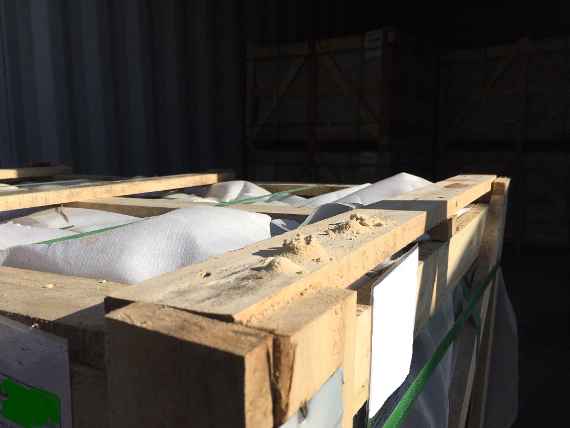The aim is to prevent the introduction and spread of harmful organisms, in particular Anoplophora glabripennis (Motschulsky).
Requirements for Wood Packaging Material
Wood packaging material (WPM) is seen worldwide as a major risk factor for the spread of dangerous and harmful wood pests. Numerous introductions and the associated spread of different types of beetles can be traced back to untreated WPM such as pallets, boxes, crates, etc.
In its plant health regulation, the EU has also specified the requirements and framework conditions for the registration and authorization of companies that treat and handle wood used for WPM in the EU according to the ISPM 15 Standard. The regulations applicable to Austria are explained in the BFW guideline for companies that produce or treat wood packaging material.
In international trade, the minimum requirements of the ISPM 15 standard has to be complied with all regulated wood packaging materials. This applies both to WPM as merchandise and to wooden boxes, pallets, etc. that are used for the secure transport of various commercial products. The requirements apply to all species of wood, i.e. both softwood and hardwood:
• Debarked:
a) The wood does not have to be completely free of bark, machine debarking is possible.
b) The remaining bark must be smaller than 3 cm - no matter how long - or wider than 3 cm, but not larger than 50 cm².
• As well as treated and marked accordingly:
a) HT (Heat Treatment) for conventional heat treatment,
b) DH (Dielectric Heating) for dielectric heat treatment,
c) MB (Methyl Bromide) for fumigation with methyl bromide,
d) SF (Sulfuryl Fluoride) for fumigation with sulfuryl fluoride.
Import checks at approved control points in Austria
Austria has no EU first entry point → all inspections in Austria have to be carried out at approved places of inspection (control points).
Strict requirements for approved control points according BFW Regulation 03/2013:
- Walk in space for inspection
- Adequate light for inspection
- Availability of a fork-lift truck with an experienced driver
- Adequate space for storage of unloaded pallets
- Availability of authorized person for opening the container according custom regulations
- Adequate space for fumigation treatment in case of non-compliance
Most forwarding agents and freight forwarders have been using IMSOC System (Information Management System for Official Controls) formally named TRACES NT since 14th December 2019 to transport their goods from the EU entry point to the approved Austrian control points. Creating a Common Health Entry Document for Plant Products = CHED-PP) addressed to the plant protection service at the EU entry point enables uncomplicated forwarding of the products to the place of destination or customer. There is no longer a phytosanitary transport document necessary. The status "approved for transfer" appears in the CHED-PP. For more information on the creation of a CHED-PP, please visit https://webgate.ec.europa.eu/
As a further consequence, the customs system is to be linked to IMSOC in the near future so that customs clearance can be processed via this. The actual national WPM online reporting system (BFW Meldesystem) will remain in place. After the inspection of the edited consignment, an officially signed, legally valid notification of release and fees is sent electronically to the registered applicants as a download via this online reporting system. This is also relevant for customs.
Registration of a shipment in the BFW reporting system
The BFW reporting system is used to register shipments in accordance with Regulation 01/2021 of the Federal Forest Office, with which the phytosanitary import controls of WPM from risk countries in accordance with EU Implementation Regulation 2021/127 will be reorganized from 1st March 2021.
In order to be able to edit consignments, you have to register in the BFW reporting system. The freight forwarder who is responsible for the load can register the shipment, but he has to get the license and authorization by the importer.
Important information about the consignment has to be uploaded in the reporting system:
- Exporter
- Bill of lading
- CHED-PP number
- Custom Code of the shipment
- EU Entry point
- Date of arrival
Inspection procedure
Shipments that are not included in the currently valid minimum control frequency and therefore are not physically checked, receive a direct approval with an officially signed notification. The applicant can download and print this notification immediately after receiving the e-mail notification of the WPM reporting system.
For shipments in the control frequency, the packaging wood of the entire load of the container or the transport unit, which can be seen on the respective Bill of Lading or other freight documents, has to be physically checked on site at the authorized control point by the inspector of the Federal Forest Office.
If no complaint can be found, approval is also given digitally by the respective control body by means of an officially signed notification.
During the phytosanitary inspection it is secured that the container can only be opened after a current residual gas measurement, which ensures that there is no more dangerous poisonous gas in the container. Then every single packaging unit is checked from all sides. This requires lifting the pallet or crate with a forklift.
If there is a complaint (non-compliance with the ISPM 15 standard), an official measure has to be initiated by the respective control body. In most cases, the container is sealed by the control body and properly post-treated (fumigated) by a licensed pest controller.
The release notice for a shipment by the Federal Forest Office always has to be presented to customs. Without this, no customs clearance can be carried out. The release document is also a fee notice (invoice).
The fees are specified in the official gazette of the Federal Forest Office for Forest (Plant Protection Fees) and are calculated according to the number of containers and the predominant product category (CN code). The fee for “desk sharing” is the same as for physically checked consignments.

